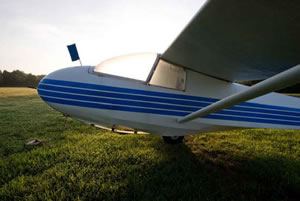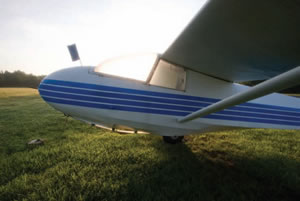HOW-TO, Techniques, & Best Practices Channel
| Having a Fling with Flare By posted Aug 3, 2009, 14:16 |
Click here to get a copy of the September 2007 Edition, so you can read and enjoy all of the excellent articles inside. Check out this article in the September 2007 print edition of StudentFilmmakers magazine, page 20.
Image Cues Can Be Subtle, but Strong...
by Ira Tiffen
Gliding. Up, up and awaaaaay! Exhilarating as it is, only the camera gets to really go along for the ride � not your audience. Making them feel they are part of the action is part of your job. Doing that best requires being able to insert the right image cues. Image cues are what filter effects are all about.
Coming up on the glider as in our example scene, the sun is coming up, too, behind it. Its brilliance literally bursts through the dew-drenched canopy. But, in the original, unfiltered scene, it is more seen than felt. Here, the upper edge of the glider, from nose to canopy to wing, cuts a clean, hard line against the silver-bright sky. We want to somehow portray the eagerness with which the glider is facing another trip aloft, an extension of the pilot�s own emotions as we visually follow along with him.
We can do that here by blurring the line a bit between the glider and its intended destination. In the second, filtered scene, a Schneider Black Frost #2 softly flares the highlights, surrounding the canopy and the rest of the upper edge of the glider as well, with a subtle glow. The glider now becomes more as �one� with the sky; its formerly distinct edge blending with its background. The effect of the sun on the viewer is more palpably felt than before.
While this effect doesn�t command your viewers� attention by its presence, its true strength lies in its subtlety. The mind picks up these image cues in the background and adds them to what it already knows. And such small things add up to make a big difference in the full message imparted by the finished image.
There is another, technical lesson from this example. The filter, creating flare and reducing contrast, does so by a re-distribution of light. And where there is more light for it to work with, it does more. So, you can see that where the dark line of the glider meets the bright sky, the effect is greater than under the glider in its shadow on the grass, where the luminance values are all lower. This knowledge will help you in deciding how to frame a scene, and when choosing effect grades. Brighter scenes may need a lower (weaker) grade. Lower contrast scenes may require a stronger grade. And, panning from bright to dark areas may cause a shift in the result that you will want to plan for, and so on.
When reaching for the sky, remember to keep a firm grasp on your traveling companions, filter effects � you�ll take your audience higher and farther than you would going it alone.
 NO FILTER
NO FILTER
 Schneider Black Frost #2
Schneider Black Frost #2
This article may not be reprinted in print or internet publications without express permission of StudentFilmmakers.com.
In over 30 years of making optical filters, Ira Tiffen created the Pro-Mist, Soft/FX, Ultra Contrast, GlimmerGlass, and others, netting him both a Technical Achievement Award from the Academy of Motion Picture Arts and Sciences and a Prime-Time Emmy Award. Elected a Fellow of the SMPTE in 2002, he is also an Associate member of the ASC, and the author of the filter section of the American Cinematographer Manual.
| Don't miss another important edition of StudentFilmmakers magazine which focuses on cutting-edge, pre-production, production, post production, and distribution technologies and techniques. 1-year, 2-year, and 3-year subscriptions available with discounts from the cover price. Back Issues are also available while copies last. Go to www.studentfilmmakers.com/store >> |
StudentFilmmakers magazine, the #1 Educational Resource for Film and Video Makers, publishes 12 editions per year. Subscribe today and get this important magazine delivered right to your doorstep every month. Each edition contains high level, educational articles for serious filmmakers and videographers like you - articles including cutting edge, real-world practices, trends, and technology, as well as in-depth inspiring interviews with independent filmmakers and experts.
There is something for everyone in each issue, whether you are a director, cinematographer, camera operator, gaffer, editor, producer, sound engineer, animator, composer, actor, screenwriter, ... With today's technology changes coming faster and faster, we are all students.
StudentFilmmakers magazine would like to hear from you!
Click here to share your comments and feedback about the magazine, monthly editions, your favorite articles, and your favorite topics.
We always welcome and appreciate your Reader Comments. View them here, and send yours to the editors today!